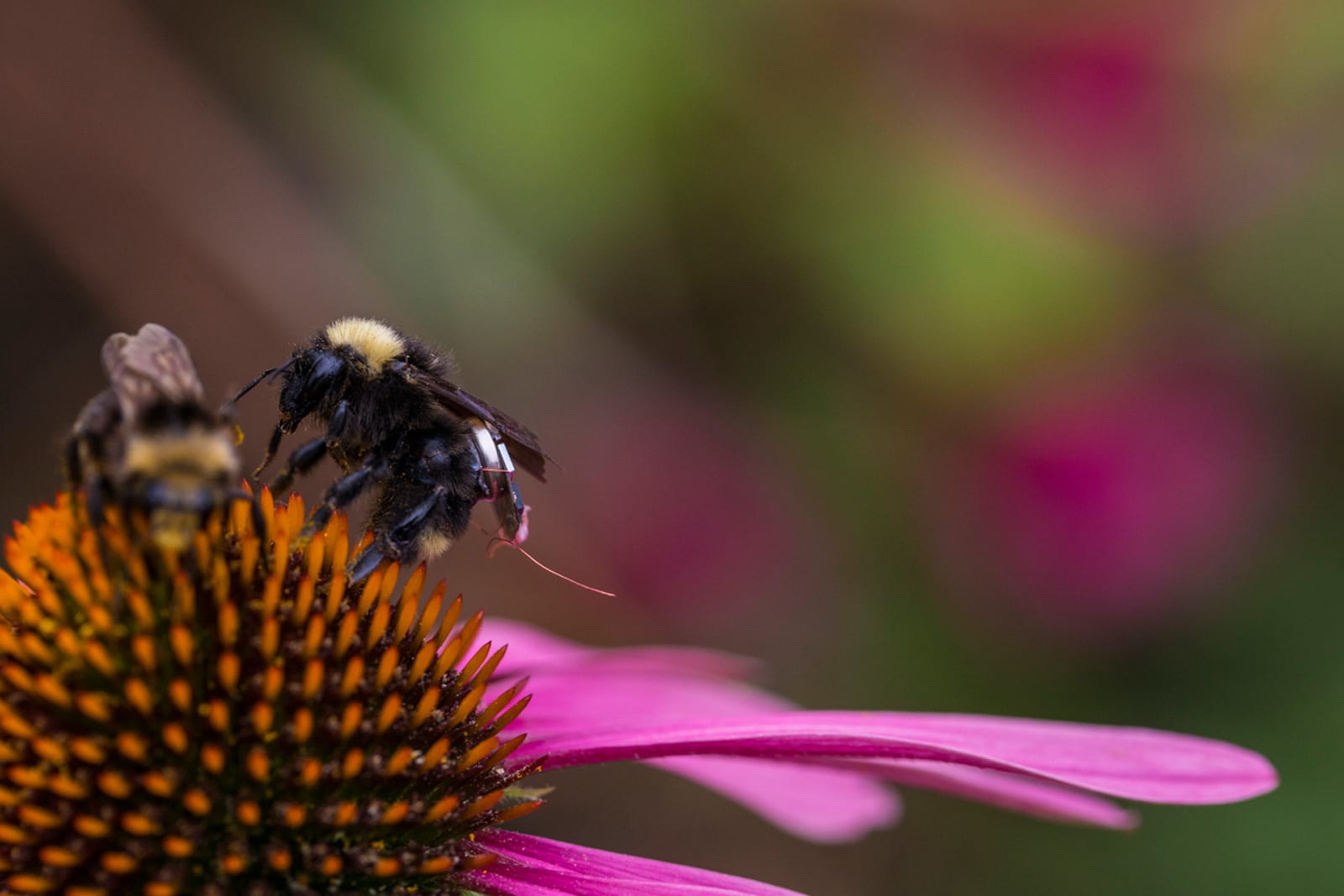Tag Archives: insect
This tiny robotic beetle travels for two hours without a battery
This Tiny Robot Beetle Runs on Methanol Instead of Electricity
When it comes to robots, most of them are powered by batteries, which in turn drive servos or other motors. But if you’re trying to build insect-sized robots, it’s tough for them to get around them without an external power source. Now, engineers have come up with a bug-sized robot that runs on methanol instead.
The specific energy stored in fuels like methanol is significantly higher than that of batteries, which means you need less of it to go just as far. With that in mind, Xiufeng Yang, Longlong Chang, and Néstor O. Pérez-Arancibia from the University of Southern California developed a tiny robot which can carry its own fuel, while keeping its size and weight down to something much closer to that of an actual insect. The robot beetle, aka “RoBeetle” measures just 15mm, weighs just 88mg, and can carry roughly 2.6 times its own weight.
This little dude ambles along using a catalytic artificial muscle that can flex and transmit movements to a leaf spring, which in turn moves its legs. Most of RoBeetle is made from carbon fiber, along with polyimide film, which are both very lightweight materials, and its musculature is made using nitinol, a metal that has a sort of “shape memory” depending on whether its hot or cold, along with platinum black, which works as a catalyst for the fuel, causing it to combust and push against the nitinol wire. An additional mechanism captures methanol vapor on opposite strokes causing the system to reset, causing an oscillation between its two states, and driving the robot forward. This method of locomotion is extremely efficient, allowing the RoBeetle to walk for hours between refuelling.
There are some limitations to the current design, which only allow RoBeetle to move in a straight line and forward, though you would think by creating separate fuel cells for backwards, left, and right motions would be feasible. While this approach makes sense for keeping weight and size down for miniature robots, I wonder if a similar approach could be used for larger robots.
[via Science Robotics via IEEE Spectrum]
Think a GoPro on Your Dog Is Cool? How About Video Cameras on Beetles?
Strapping a GoPro onto your pet can result in some pretty amusing video footage. But what if you prefer insects to mammals? There’s no way you could fit a regular action camera onto one of those, unless it’s one of those giant bird-eating spiders you find in South America maybe. Now, thanks to the miracles of modern science and technology, we have a video camera that’s tiny enough to attach to a beetle.
Researchers from the University of Washington’s Paul G. Allen School of Computer Science & Engineering, working under a fellowship grant from Microsoft have come up with a miniature camera that weighs just 250 milligrams. That makes it light enough to be carried by some sturdier insects, including the death-feigning beetle and a pinacate beetle.
The teensy camera unit includes an image sensor, processing circuitry, a Bluetooth transmitter, and a battery. But given the size limitations, its image quality isn’t very good at this point, capturing low resolution greyscale images at a very low frame rate. It streams images at somewhere from 1 to 5 frames per second, with a 160 x 120 resolution, and is capable of being remotely steered so a wider field of view can be observed.
The research team also developed a tiny, 2cm long robot that can also carry a steerable camera, which has the potential to reduce robot power consumption needs, since it doesn’t need to move the whole robot to survey a scene. I can only imagine the potential for building tiny camera robots that look like insects to carry out espionage.
If you’re interested in learning more about the beetle-cam, the full research paper is available from Science Robotics.
[via Gizmodo]
HAMR Jr. Is a Tiny Robot Insect Less Than an Inch Long
As the miniaturization of electronic and electromechanical components continues to improve, so does the ability for engineers to create tiny robots. I recently came across this miniature robot that’s roughly the width of a U.S. penny, but is capable of relatively complex movements.

Researchers at Harvard’s John A. Paulson School of Engineering and Applied Sciences along with the Wyss Institute for Biologically-inspired Engineering developed the HAMR-Jr, a robotic little dude that can easily fit in the palm of your hand – and tickle it while it skitters about.

The quadrupedal microrobot measures just 2.25 cm long – or about 0.88 inches, and weighs only 320 mg. Despite its size, it has eight degrees of freedom, each of which can be actuated independently using piezoelectric components. When electricity is applied to its parts, they vibrate, and when used in the proper combination, they allow the robot to walk, run, leap, and turn. This guy is also crazy fast, capable of traversing a distance 13.9 times its body length in just a second.
Thanks to its pop-up style MEMS assembly process, the design of the HAMR platform makes it possible to build versions of the robot in a variety of sizes, without major changes to its fabrication. In fact, the team had previously built a cockroach-sized version of the robot, which you can see in the image and video above for size comparison. In theory, this technique could be used to produce robots for all kinds of uses, from medical to industrial applications
[via designboom]
Toss a Giant Crochet Spider on Your Couch

Most spiders are actually good for the environment, wiping out a wide variety of pests, including many that carry diseases. Still they’re pretty creepy looking, and the bigger they are, the scarier these eight-legged insects can be. But if you absolutely love spiders, then maybe you should get a gigantic one that you can toss around the couch amongst your throw pillows.

If you’re looking for something fun to do with your spare time, get out the yarn and knitting needles, and knit yourself a giant spider! MyTwinsCrochetNL sells a crochet pattern that makes a massive 20″ diameter spider that’s sure to get a rise out of anyone you toss it onto.
Since this is a DIY spider, you can make it in any color you want. So if you like the idea of a fiery orange spider or a lime green spider, that’s cool.

Unfortunately, if you don’t know how to crochet, you’re out of luck, because they’re only selling the pattern files. But if you have the skills to pull it off, you can get started for just about $10 for the pattern, then about 500 grams of acrylic yarn. They offer patterns in US English, UK English, German, and Dutch, because the giant bugs know no borders.

[via Oddity Mall]
App allows citizen scientists to track monarch butterfly migration
 If you've ever pulled out your phone to take a picture of a butterfly, researchers want your help. A team from the University of Maine is using an app that lets citizens scientists along the East Coast take photos of monarch butterfly migration sites...
If you've ever pulled out your phone to take a picture of a butterfly, researchers want your help. A team from the University of Maine is using an app that lets citizens scientists along the East Coast take photos of monarch butterfly migration sites...
The Robo Firefly is a Giant Insect Drone
Like bugs? The Robo Firefly is being called the first insect-like consumer drone. So if you have ever dreamed of piloting your very own insect in the skies, this is your chance. This flying critter is modeled after an insect, so this doesn’t make a lot of noise when it flies.

Its wing motion mimics that of insects, making its flight highly efficient. It also has built-in strobe lights so you can create a visual show in the air after dark. Hence the name Firefly. Its wings flap 25 times per second and this is how it gets its lift. That is five times in the blink of an eye, which is pretty impressive. It can reach a top speed of 12.5 mph. The insect drone connects to your smartphone and has a range of 100 meters.
You can get it fully assembled or in a makers edition that you can build yourself. There’s also a pro version for longer flights. Prices start at $88 on Indiegogo. Is it just me or is the narrator of the video using a totally fake accent? I guess he thinks he’s David Attenborough.
Insects could be extinct within a century, scientists say
 Insects are dying so rapidly, they could disappear within 100 years, according to the first global scientific review on their decline. A third of species are endangered and more than 40 percent face the threat of extinction in the next few decades, a...
Insects are dying so rapidly, they could disappear within 100 years, according to the first global scientific review on their decline. A third of species are endangered and more than 40 percent face the threat of extinction in the next few decades, a...
Bees with tiny sensor backpacks could help farmers track crops
 Farmers can use drones to monitor their fields, but they have their limits when they can rarely fly for more than 20 to 30 minutes at a time. University of Washington researchers might have a smarter way: recruit some insect friends. They've develope...
Farmers can use drones to monitor their fields, but they have their limits when they can rarely fly for more than 20 to 30 minutes at a time. University of Washington researchers might have a smarter way: recruit some insect friends. They've develope...


